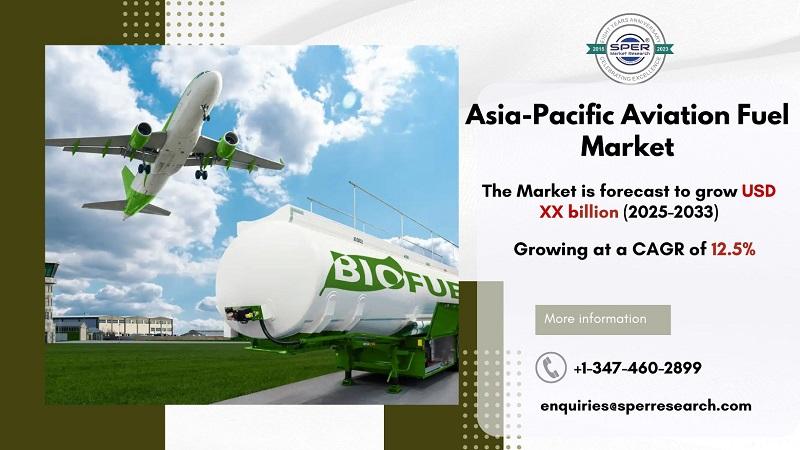Notifications

4 minutes, 57 seconds
-5 Views 0 Comments 0 Likes 0 Reviews

Aviation fuel is a specific sort of petroleum-based fuel used to propel aeroplanes. It is designed to exceed stringent quality and safety requirements, ensuring consistent engine performance at high altitudes and in different temperatures. There are two basic types: Jet-A (for turbine engines) and Avgas (for piston engines). Aircraft fuel is critical for commercial, military, and private aircraft, as it enables global connectivity and logistics. Its composition has been modified to improve combustion, reduce emissions, and retain stability throughout long-term flight operations.
According to SPER market research, ‘Asia-Pacific Aviation Fuel Market Size- By Fuel Type, By Application - Regional Outlook, Competitive Strategies and Segment Forecast to 2033’ state that the Asia-Pacific Aviation Fuel Market is predicted to reach XX billion by 2033 with a CAGR of 12.5%.
Drivers: Infrastructure development contributes significantly to aviation fuel demand. As air travel demand rises, existing airports frequently expand to accommodate larger aircraft, higher passenger traffic, and more airline operations. This extension will involve the building of new runways, terminals, taxiways, and other amenities. More infrastructure equals more flights, which leads to increased demand for aviation fuel. New airports may be built in areas experiencing significant economic expansion or where air travel infrastructure is underdeveloped in order to meet increased air travel demand. These newly constructed airports will require significant amounts of aviation fuel to support operations once they are operational.
Restraints: The primary factor projected to stymie aviation fuel market expansion is fuel price. The hefty cost is anticipated to slow market growth. The increased fuel cost is related to the higher Brent crude oil price, as jet fuel is a derivative of Brent crude oil. The price of Brent crude oil is rising due to a supply-demand imbalance. The increased demand for Brent crude oil, along with a scarcity of crude oil production, drives up prices.
In 2024, China will continue to dominate the Asia-Pacific aviation fuel market. This leadership is driven by its extensive domestic aviation network, growing international connectivity, and continued investment in airport infrastructure and fleet expansion. India and Japan also show strong growth, supported by increasing air travel demand and technological advancements. Meanwhile, Southeast Asian countries are rapidly emerging due to the expansion of low-cost carriers and rising tourism.
Request a Free Sample Report: https://www.sperresearch.com/report-store/asia-pacific-aviation-fuel-market.aspx?sample=1
Some of the key market players are Bharat Petroleum Corp Ltd, BP plc, Chevron Corporation, China Aviation Oil Corporation Ltd, Exxon Mobil Corporation, Pertamina Persero PT, Petronas Aviation Sdn Bhd, Royal Dutch Shell Plc, Vitol Holding BV, World Fuel Services Corp, Others.
Asia-Pacific Aviation Fuel Market Segmentation:
By Fuel Type: Based on the Fuel Type, Asia-Pacific Aviation Fuel Market is segmented as; Air Turbine Fuel, Aviation Biofuel, Others.
By Application: Based on the Application, Asia-Pacific Aviation Fuel Market is segmented as; Commercial Aircraft, Military Aircraft, General Aviation.
By Region: This research also includes data for China, India, Japan, South Korea, Australia and New Zealand, Indonesia, Thailand, Malaysia, Vietnam, Philippines, Singapore, Rest of Asia-Pacific.
For More Information, refer to below link: –
APAC Aviation Fuel Market Outlook
Related Reports:
Follow Us –
LinkedIn | Instagram | Facebook | Twitter
Contact Us:
enquiries@sperresearch.com
+1–347–460–2899
Asia Pacific Aviation Fuel Market Asia Pacific Sustainable Aviation Fuel Market APAC Aviation Fuel Market Asia Pacific Aviation Fuel Market Growth Asia Pacific Aviation Fuel Market Size Asia Pacific Aviation Fuel Market Trends Asia Pacific Aviation Fuel Market Share Asia Pacific Aviation Fuel Market Revenue Asia Pacific Aviation Fuel Market Demand Asia Pacific Aviation Fuel Market Challenges

